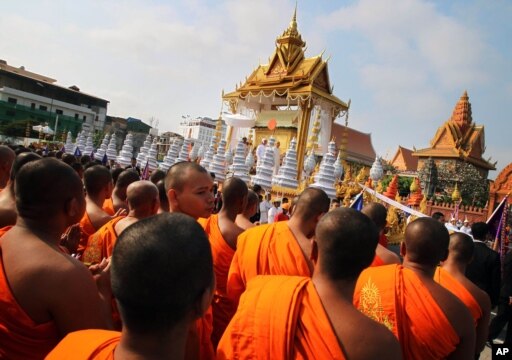 The coffin carrying the late former Cambodian King Norodom Sihanouk in a funeral procession leaves the Royal Palace in Phnom Penh, February 1, 2013.
The coffin carrying the late former Cambodian King Norodom Sihanouk in a funeral procession leaves the Royal Palace in Phnom Penh, February 1, 2013.
February 5, 2013,
Cambodians have bid goodbye with tears, chanting and fireworks to
former King Norodom Sihanouk, their revered King-Father who led them
through half a century of political tumult that took them into the abyss
of genocidal Khmer Rouge rule and back out again.
Hundreds of
thousands of Cambodians thronged the capital on Monday for the elaborate
royal cremation of the maddening mercurial leader whose charm often
overshadowed missteps that to most of his countrymen have faded away in a
fog of nostalgia for a simpler time.
Sihanouk's elaborate funeral
rites - mingling Hindu, Buddhist and animist traditions - were last
seen 53 years ago with the death of his father, King Norodom Suramarit.
And they may never be seen again in a rapidly modernising country where
the monarchy has lost much of its power and glamour.
After sunset,
Sihanouk's son King Norodom Sihamoni and widow, Queen Mother Norodom
Monineath, both weeping, ignited the funeral pyre inside a temple-like,
15-storey-high crematorium. Howitzers fired salvos and fireworks lit up
the sky when they exited about half-an-hour later.
After the
cremation, Sihamoni handed out gifts to some 400 prisoners he had
earlier pardoned as part of the mourning for his father, who he said was
"in heaven, near the Lord Buddha, forever".
The cremation took
place within a walled compound where 90 Buddhist monks - one for each
year of Sihanouk's life as counted by Cambodians - chanted around the
flower-decked, gilt coffin. Only the country's elite and foreign
dignitaries were allowed inside the cremation ground, along with
courtiers dressed in pantaloons and soldiers in 19th century-style
uniforms with spiked helmets and swords.
Sihanouk's body had been lying in state since he died of a heart attack in Beijing on October 15 at the age of 89.
The
cremation was the climax of seven days of official mourning for
Sihanouk, who was placed on the throne by the French as a teenager.
Instead of proving the puppet the colonials had hoped for, Sihanouk went
on to win independence, then rule the country both as monarch and head
of state until ousted in a 1970 coup. Internationally, he was a leading
member of the non-aligned movement and heightened his small country's
profile in the world.
A prideful Sihanouk sided with the Khmer
Rouge against the US-backed government, but after the victory of the
ultra-communists in 1975, he and his wife were held prisoners in the
palace. Five of his children died during the reign of terror.
A
consummate survivor, Sihanouk emerged as a leader of an insurgency
fighting a Phnom Penh government installed by the Vietnamese and went on
to broker a peace accord that enabled his return to the throne in 1993.
He
abdicated 11 years later in favour of Sihamoni, a 59-year-old former
ballet dancer who had spent most of his life in European artistic
circles and has proven a low-keyed constitutional monarch overshadowed
by strongman Prime Minister Hun Sen.
Sihanouk's dark side,
particularly his cooperation with the Khmer Rouge and his often brutal
suppression of dissent, has been publicly ignored as loudspeakers
broadcast eulogies and television stations show old clips of Sihanouk's
triumphs and






No comments:
Post a Comment